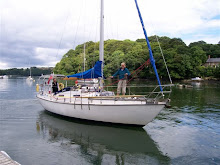
Turkish White Christmas
A belated Merry Christmas and a Happy New Year to our dear reader. As you can see, we have found some mountains to climb, but more of that anon.
 Finike Marina, our home for the winter.
Finike Marina, our home for the winter.November proved to be a splendid month for us to cruise along the Lycian coast, awaiting the onset of winter. Most of the gulets were laid up, as were most of the other yachts.
More often than not we had the place to ourselves. We rarely shared an anchorage, the sun shone most of the time, and the sea was still warm enough for us to swim whenever the fancy took us. The occasional blow held no terrors for us, safe, sheltered anchorages were never far away.
On one occasion over a twenty four hour period, the wind got up to gale force 8. We found an anchorage off Kaleucagiz that offers protected from both waves and swell. While anchoring in six metres of water with all the swinging room one needed, I let out forty metres of chain in good, thick, gooey mud. (Well, it’s no use in the chain locker, is it?) We were as safe as houses, and perfectly comfortable.
 Bucak Deniz near Kas
Bucak Deniz near KasWe spent several days at anchor in Bucak Deniz. First impressions were not at all good, but we warmed to the place. They are building a new marina here as well as making a new bypass road.
Extensive and varied feats of civil engineering are taking place, and we had a grandstand view. Massive diggers, drilling machines, cranes and lorries laboured from dawn till dusk, moving rock from where a surveyor didn’t want it, to a place where it was needed.
It was particularly fascinating to see how delicate some of these giant diggers could be, as they painstakingly placed a boulder weighing several tons in exactly the right place.
We took on the role of unofficial, unpaid, unknown, site supervisors, from the safety of our cockpit. I do hope they can manage without us over the winter.
 Part of the Roman theatre at Myra
Part of the Roman theatre at MyraWe also passed close by, but didn’t visit Demre. The church here is dedicated to Saint Nicholas, the patron saint of sailors and pawn brokers! Apparently he was martyred here in 655 AD. A most uncharitable act, I think, killing Santa Clause.
 Elusive Mediterranean summits.
Elusive Mediterranean summits.(With apologies to Victor Saunders)
The tantalizing glimpses of distant snow capped mountains convinced us that Finike was a good place for two sailing mountaineers to spend the winter. (We tell fellow sailors that we are really climbers. What they don’t know is that we tell climbers that we are really sailors).
 Pippa with the bit between her teeth
Pippa with the bit between her teethFrustration is a common emotion experienced by those who would go to the hills of the Mediterranean. The obstacles are legion. The main problem is that they don’t have 200
years of dedicated sheep farming. Everything above sea level + 500ft is covered in impenetrably dense and unbelievably spiky Maqui. There should be a law against it.
 Just keep going till you run out of up.
Just keep going till you run out of up.Apparently Turkey does have topographical maps, but they are a state secret and known only to the army. What they don’t want us to know is a mystery. Maps that are available to visiting hill bashers are at best a joke, at worst a cynical plot to drive the would be rambler completely nuts.
 Who dares wins.
Who dares wins.(With apologies to the SAS)
It was probably a map reading error, for which I am well known. I tell my critics “I have climbed many mountains; I just don’t always know which ones”. But any way, we found a chink in their amour while on a sight seeing tour with some fellow sailing walkers.
“You see the forestry track, traversing that hill over there?” “It’s above the snow line”. “Let’s hire a car over Christmas and go have a look”. “Eureka!” The track (not on the map) led us through a magnificent cedar forest and eventually to a modest summit of about 2,300 meters. On Boxing Day we returned and bagged its neighbour.
 Forbidden summits?
Forbidden summits?(Apologies to the Turkish tourist board)
The highest mountains hereabouts seem to be best approached from a few miles down this road. There is, however, a fly in the ointment in the shape of a locked barrier across the road, an official looking sign, and someone who may or may not be a park warden, who says “No”. That’s all he says. Just “No”. He offers no explanation, hands out no leaflet, gives no hope of arbitration. Just hints that he wishes we would go away so he could continue fixing his car. It comes hard to one never wanting to take no for an answer. It seems we have another project.
 What have we here?
What have we here?Pippa has been unable to identify these flowers. We are offering one day of sailing or hill bashing in the Mediterranean, to the first person to identify them. (Conditions apply).
 Running repairs
Running repairsA terrific hail storm last week, left hail stones up to half an inch in diameter on our deck.
Unfortunately, during the tempest our windex lost its tail. Enquiries at the local chandlery revealed that a replacement unit from Istanbul would cost £40 plus postage.
Hmm, I thought. Perhaps it can be repaired. And indeed it could. A few minutes of surgery to a fly swat and some seizing wire as a counter balance seems to have done the trick. Time will tell.











































